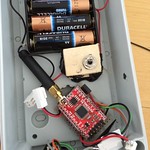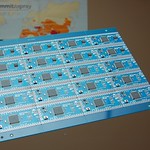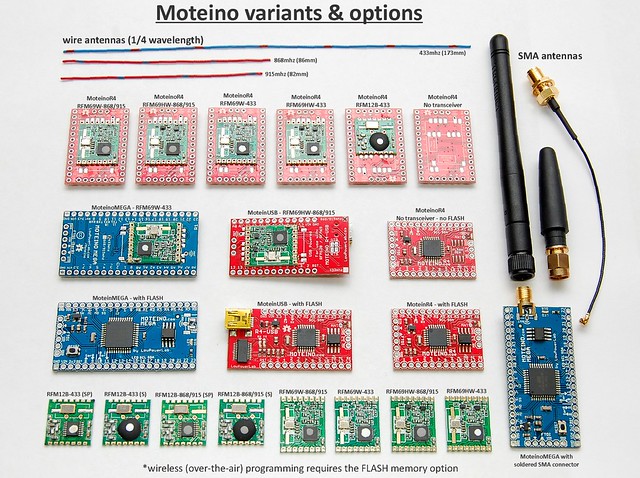My vision for Moteino Framework was to create an affordable/open/ideal/easy hardware platform that would fuel a new generation of wireless internet-of-things, and I think it came out pretty decent. My Hackaday Prize entry even made it in the top 50 semifinalists (out of 800+). More devices are being added to the Moteino Framework and existing ones are being improved to make it fun for those makers who like to DIY and solder their internet-of-things from easy to assemble kits. The end users have maximum freedom as far as using/building stuff with Moteino. They can build absoltely everything from scratch, as some have done, but some prefer to just save time and buy building blocks. Hence I funded my way through this adventure by selling ready made Moteinos and kits in my online webshop.
People have asked many times why the Moteino was designed the way it was, and why not use this and that and the other type of MCU, transceiver type, radio band, or wireless technology. The number one reason why Moteinos are what they are today is because in the end they need to be designed to manufacture, work well, be reliable, license free, easy and fun to use in a friendly board format, cheap to buy or make, achieve long open air range or excellent indoor obstacle penetration when used with transceivers, etc. Here is my reasoning behind all these decisions and the answers to some frequently asked questions.
MCU choice – Why not ATTiny/ARM chips? They are cheaper!
Because it makes little sense, economically and practically, for what I had in mind. ATtinys are very memory challenged (typically FLASH not more than 8KB and SRAM not more than 512b), are somewhat supported in the Arduino IDE with some tweaks, don’t generally have real dedicated SPI/i2c/serial hardware support (some have SPI or serial). The bootloaders typically take a big chunk of the already limited FLASH. They cost less than an ATMega328 but the savings would never justify the features tradeoff unless for projects where all you need is a few I/O and you program it once and never have to touch it again. In fact some of the “larger” ATTinys are getting close in price to the popular ATMega328. ARM is a steep learning curve, the chains are not very easy to get going and the large fine pitch SMD chips are harder to get started with unless you get ready made development boards. Tools are also costly and the general public has an easier time with Arduino/AVR.
Could be much smaller with ATTiny or with other board layouts/set of hardware
Really? I could shrink the Moteino to the size of a fingernail (I actually did a project where the diameter of the circular board was 10mm with a QFN-28 ATMega328 on it, no kidding, the ICSP was on a header that would snap off after programming, leaving the circular 10mm finished board). You can do almost anything you can put your mind to. The big question is are they designed for manufacturability? Are they easy to use to the average electronic hobbyist as well as for the experienced maker? Are they a building block for greater things or are they a stumbling block? I am personally willing to invest a few bucks more to get the luxury of a tool that is not a pain to get started with and just works.
Why not CC1101 / NRF24L01 / other cheap ebay transmitters?

I really wanted to like these and I’ve done my own open air range testing with these NRF radios before I moved on to settling on RFM69. They are simply hopeless in terms of range. They have higher power versions (the PA+LNA) but those are hopeless in terms of size and power consumption and cost several times more than a RFM69. Most versions I’ve seen have a 2×4 header that was a challenge to fit flat/tight anywhere.
Why not use “inexpensive off the shelf” transmitter and receiver pairs? After all, they are just $1 on ebay!

Wow, I’m not impressed. They are inexpensive and you get what you pay for, a leg or an arm. I want a full set. You can use these but you will be sorry the first time you build a project where you want to get an ACK back from a node, ie need both transmit and receive (transceiving). Or transmit through an extra wall or from across the street. They have no hardware packet engine, encryption or CRC or anything close to what I want in terms of features. Sure you can do all that in software but I’d rather code my new sensors and ideas than spend my energy on reinventing the wheel only to save a few bucks. Also I don’t consider ebay a reliable stream of component sourcing.
How about Xbee/Zigbee?
Not much to say here except my very first experiments were with XBees which were about half the range of RFM12B and about 4X the price and power consumption was not nearly ideal. Quickly became obvious this is not the way to go.
 Fun fact: on the side is a user submitted photo in which he is testing a Moteino+RFM69 with tweaked RFM69 Lib settings for low bitrate/bandwidth and tweaked antenna to achieve an impressive 1.75Km range. This is fantastic and it means Moteinos are great for long range telemetry where bluetooth, wifi and other alternative technologies would be impossible to use and cost prohibitive. When I get stories like these about my product this makes my day. The full story and details are in my blog forum.
Fun fact: on the side is a user submitted photo in which he is testing a Moteino+RFM69 with tweaked RFM69 Lib settings for low bitrate/bandwidth and tweaked antenna to achieve an impressive 1.75Km range. This is fantastic and it means Moteinos are great for long range telemetry where bluetooth, wifi and other alternative technologies would be impossible to use and cost prohibitive. When I get stories like these about my product this makes my day. The full story and details are in my blog forum.
The choice of RFM69
So I’ve gone from RFM12B (which is still supported on all Moteinos) to RFM69 (W and HW). The reasons are many, and it worked out as a great trasceiver, affordable, and the RFM69 library I’ve created for it has become very widely used. Meshing is also possible for special applications. But in most cases meshing is not needed because by tweaking the settings, ranges of over a mile is achievable. The out of box RFM69 lib settings will give you several hundred meters in open air and should easily cover a 1 acre typical residential property/home. By contrast RFM12B could barely get from one end to the other in my home, with dead spots and dropped packets, unless I seriously decreased the bitrate. It’s also the right size, fits perfectly on the belly of all Moteinos and is the right price. The end product is a very compact node that can fit in almost anything, can be easily powered from a range of sources, and doesn’t require twisty weird assembly and microscopical soldering to bring it to life.
Design for manufacture - IS YOUR PROJECT "PRODUCTIZABLE" ?
 This is very important if anything you make is ever meant to scale. I see a lot of projects that are cool, but have more of an artisan feel to them, which is perfectly fine, but in terms of making 100 or 1000 of them, it would require a small army of people or countless hours to solder and custom fit/bend/twist/test. I hope the THP judges will see these issues and take them into account when judging between the good and great THP semifinalists based on this consideration.
This is very important if anything you make is ever meant to scale. I see a lot of projects that are cool, but have more of an artisan feel to them, which is perfectly fine, but in terms of making 100 or 1000 of them, it would require a small army of people or countless hours to solder and custom fit/bend/twist/test. I hope the THP judges will see these issues and take them into account when judging between the good and great THP semifinalists based on this consideration.  PCB making is affordable and anybody can do it with all the open/free PCB layout programs out there, but once you move from individual boards to panelized designs that need to be assembled into a pick and place it’s a whole different story, and a lot more things come into play. EEVBlog and others have done a good job explaining some of the challenges of designing for manufacture. This factor alone will make the difference between a good or bad design in the long run. With Moteino I tried to think of manufacturability from the start. I knew if my design was bad it would never get past a revision or two and nobody would want it. If it was good then I would eventually end up requiring machine assembly and rapid testing. Currently all Moteinos are assembled on my new real pick and place and reflowed in a real reflow oven. Yes I believed in my vision so much I ended up buying a pick and place to make my projects (I was getting tired of doing it manually too). Then they are bootloaded and tested manually using a jig I made for them similar to this. It goes very fast but it was a long journey to get here, nevertheless quite rewarding and fulfilling one. Here's some eye candy:
PCB making is affordable and anybody can do it with all the open/free PCB layout programs out there, but once you move from individual boards to panelized designs that need to be assembled into a pick and place it’s a whole different story, and a lot more things come into play. EEVBlog and others have done a good job explaining some of the challenges of designing for manufacture. This factor alone will make the difference between a good or bad design in the long run. With Moteino I tried to think of manufacturability from the start. I knew if my design was bad it would never get past a revision or two and nobody would want it. If it was good then I would eventually end up requiring machine assembly and rapid testing. Currently all Moteinos are assembled on my new real pick and place and reflowed in a real reflow oven. Yes I believed in my vision so much I ended up buying a pick and place to make my projects (I was getting tired of doing it manually too). Then they are bootloaded and tested manually using a jig I made for them similar to this. It goes very fast but it was a long journey to get here, nevertheless quite rewarding and fulfilling one. Here's some eye candy:
 Felix Rusu
Felix Rusu

Discussions
Become a Hackaday.io Member
Create an account to leave a comment. Already have an account? Log In.